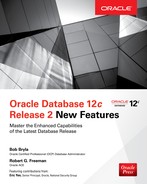Contents
1 Getting Started with Oracle Database 12c Release 2
Downloading Oracle Database 12c Release 2 Components
Preparing the Operating System for Oracle Database 12c Release 2
Review the Installation Guide and Readme Files
Make Sure Your OS Platform Has All Required Updates Installed
Make Sure Your Platform Meets the Minimum Requirements
Create the Required OS Groups and Users
Configure the Kernel Parameters
Installing Oracle Database 12c Release 2
Prepare the Installation Environment
Install Oracle Database 12c Release 2 Using the OUI
Installing Oracle Database 12c Release 2 Grid Infrastructure
Prepare to Install Oracle Database 12c Release 2 Grid Infrastructure
Stage Oracle Database 12c Release 2 Grid Infrastructure
Deinstalling Oracle Database 12c Release 2
2 Installing or Upgrading to Oracle Database 12c Release 2
Installing Oracle Database 12c Release 2 Grid Infrastructure
Configure Grid Infrastructure and Start ASM
Add the RECO Disk Group Using asmca
Creating a New Oracle Database 12c Release 2 Database
Upgrading to Oracle Database 12c Release 2: Traditional Architecture
The Last Word on Upgrading the Traditional Architecture
Upgrading to Oracle Database 12c Release 2: Multitenant Architecture
Upgrade Methods for Multitenant Databases in Oracle Database 12c Release 2
Going...Going...Gone: Deprecated and Desupported Features
Features Deprecated in Oracle Database 12c Release 2
Features Desupported in Oracle Database 12c Release 2
Deprecated Parameters in Oracle Database 12c Release 2
Desupported Parameters in Oracle Database 12c Release 2
3 Oracle Database 12c Release 2 Multitenant New Features
New Features Related to Creating Pluggable Databases
Support for Thousands of PDBs for Each Container Database
Creating a PDB with a Default Tablespace
Support for Different Character Sets in PDBs
PDB Support for Different Database Time Zones
PDB Support for Different Database Time Zone Files
Moving, Copying, and Migrating PDBs
Cloning a PDB in READ WRITE Mode
Incrementally Refreshing a Read-Only PDB
Manually Transporting PDBs Across Platforms
Using PDB Archive Files when Unplugging a PDB
PDB Security: Lockdown Profiles
Multitenant Performance-Related New Features
Controlling SGA Use at the PDB Level
Resource Manager Changes Related to CDBs and PDBs
4 Application Containers and Hints Thereof
Creating the Application Container
Creating the Application in the Application Root
Installing, Upgrading, and Patching the Application Container
Using Hints in the Containers Query
5 Administrative, High Availability, and Security New Features
Converting Nonpartitioned Tables to Partitioned Tables
Creating a New Table with Partition Characteristics
RMAN High Availability and Security Enhancements
Using RMAN to Duplicate TDE Tablespaces
Cross-Platform Transport Using RMAN
Backup and Recovery of Sparse Databases on Exadata
Cloud Control, PDB Archives, and RMAN, Oh My!
Unplugging a PDB Using RMAN and Cloud Control
Plugging In a PDB Using RMAN and Cloud Control
7 Performance-Related New Features
Dynamic Memory Area for In-Memory Objects
Prerequisites for Setting Up an NFS Server in the Database
Installing NFS Server in the Database
Using the NFS Client Interface
Tuning NFS Server in the Database
OFS Dynamic Performance and Data Dictionary Views
Using Advanced Index Compression
Using COMPRESS in Oracle Database 11g
Using COMPRESS ADVANCED LOW in Oracle Database 12c Release 1
Improvements to Hybrid Columnar Compression (HCC)
HCC with Automatic Data Optimization (ADO)
9 Big Data, Business Intelligence, and Data Warehousing New Features
Leveraging New Partitioning Methods
Using Interval Partitioning with Subpartitions
List Partitioning Enhancements
Materialized View Performance Improvements
10 Utilities and Scheduler New Features
Oracle Data Pump Parallel Metadata Management
External Table Access Driver Improvements
11 New Features for Developers, Report Writers, and Power Users
Configuring Approximate Query Processing
Using Approximate Query Processing
Data Dictionary and Data Type Enhancements
12 Integrating with Oracle Enterprise Manager Cloud Control 13c Release 2
Configuring a Cloud Control Repository
Leveraging New Cloud Control 13c Features
Support for Oracle Database 12c Release 2

